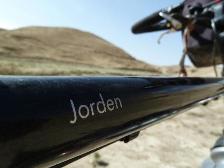My bicycle
This is the bicycle that is transporting me around the world:

Description
It is a bicycle specifically build for long-distance touring, with a strong frame and rims and the necessary racks to mount my baggage. Here are some key specifications:
Brand: Koga Miyata Signature Build (each component is individually selected)
Frame: KS-TR28
Group-set: Shimano Deore XT
Chain, Chain-ring and cassette have been changed several times, but tend to be Shimano Deore XT, as it lasts much longer than cheap components
Handlebar: Koga multigrip (butterfly) with 2 horns mounted for extra comfort.
Brakes: Shimana Deore XT brake-handles, but with no-name brake-pads (they last much longer than the soft shimano-ones)
Rims: KM21 Xstrong, 36 spokes in front, 40 in back
Spokes: Sapim
Racks: Tubus with front-kickstand
Integrated ring-lock: AXA defender (I carry a thick steel wire also)
Saddle: Brooks leather (very comfortable, after 3000km, when it has been broken in)
Mudguards: SKS Chromoplastic
Pedals: Changed, but always non-click-pedals
Weight: 15.7 kg, unloaded
Name
From production, my bicycle comes with a name. “Jorden” means “The Earth” in Danish, and it is considered a tribute to our beautiful planet

Which bike is good for touring?
Any bike!
Don’t let your dreams of a bicycle adventure be held back because you don’t have the perfect bike. Your old raggedy bike could likely take you across an entire continent, though it might break down a bit. Don’t worry, it’ll only add to the adventure. Tough times = good stories.
If you are looking to buy a new bike for touring consider these thing:
Comfort
It is the absolute most important thing about your bike, as you’ll be spending hours after hours on this instrument. Basically, the bike needs to be comfortable to ride and this is more important than speed, looks and weight.
Strong frame and wheels
Your are adding 20-30kg of baggage, so make sure that the frame is strong. More important, your wheels, rims and spokes need to be strong and sturdy, especially if you intent on riding gravelroads. Personally, I have 40 spokes on the rear whell and 36 on the front, and have only broken one spoke in more than 50.000km.
Racks
You’ll have to mount racks on the bike, so make sure it has the necessary bolt-fittings that allows this (though you could invent something yourself). Dependent on the length of your trip and the diversity of the landscape you’ll need to carry a certain amount of gear. A month stroll through Thailand doesn’t require nearly as much baggage as crossing the Himalayas and sleeping in tents in 4000m height at superlow temperatures.
Most tourers have the comfort of back- and front panniers, though some lightweight tourers survive with only the back panniers.
Again, get some strong racks that doesn’t break. Tubus racks are strong and sturdy. They are made of steel, so you can easily weld them together if they should break in a tiny Turkish village.
Saddle and handlebar
Comfort, comfort, comfort. A nice leather saddle will be very comfortable once it is “broken in” and takes shape after your butt. A handlebar with options for various hand-positions will allow easier bloodcirculation to your hands and avoid finger-numbness.
Upright riding position
Personally, I consider this be be very important. Get a bicycle where you sit more upright, so you can see the world that your are traversing. A competition race- or mountainbike will often crunch you together, staring down into the road, so avoid this.
Better to have a more granny-position, so that your neck and back doesn’t ache all day.
Keep it simple
Be carefull about chosing too many complicated and technical details. Simple stuff can easier be fixed and replaced, especially in remote destinations.
In other words, I would choose good old cable-operated V brakes over hydraulic disc brakes, for an example

